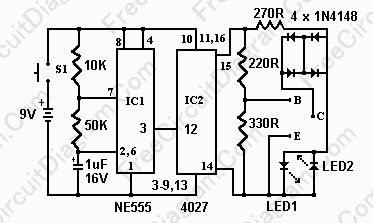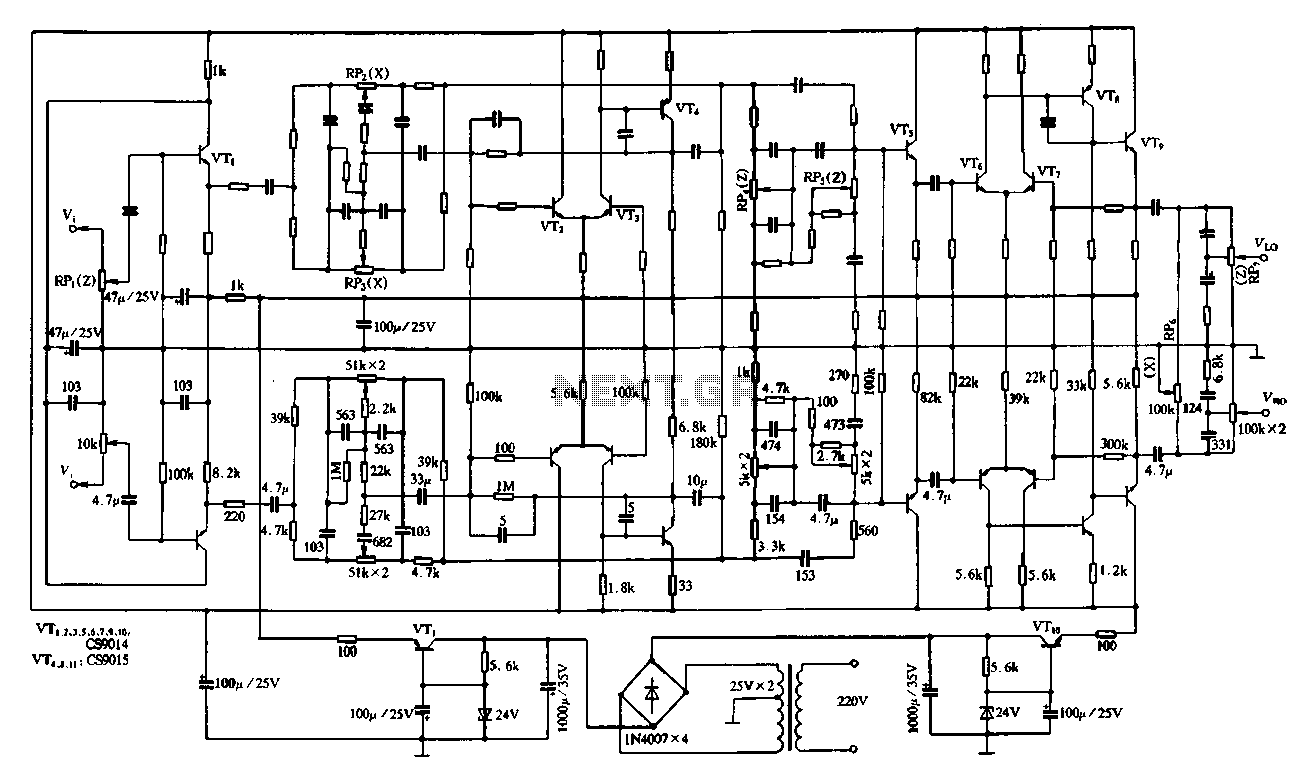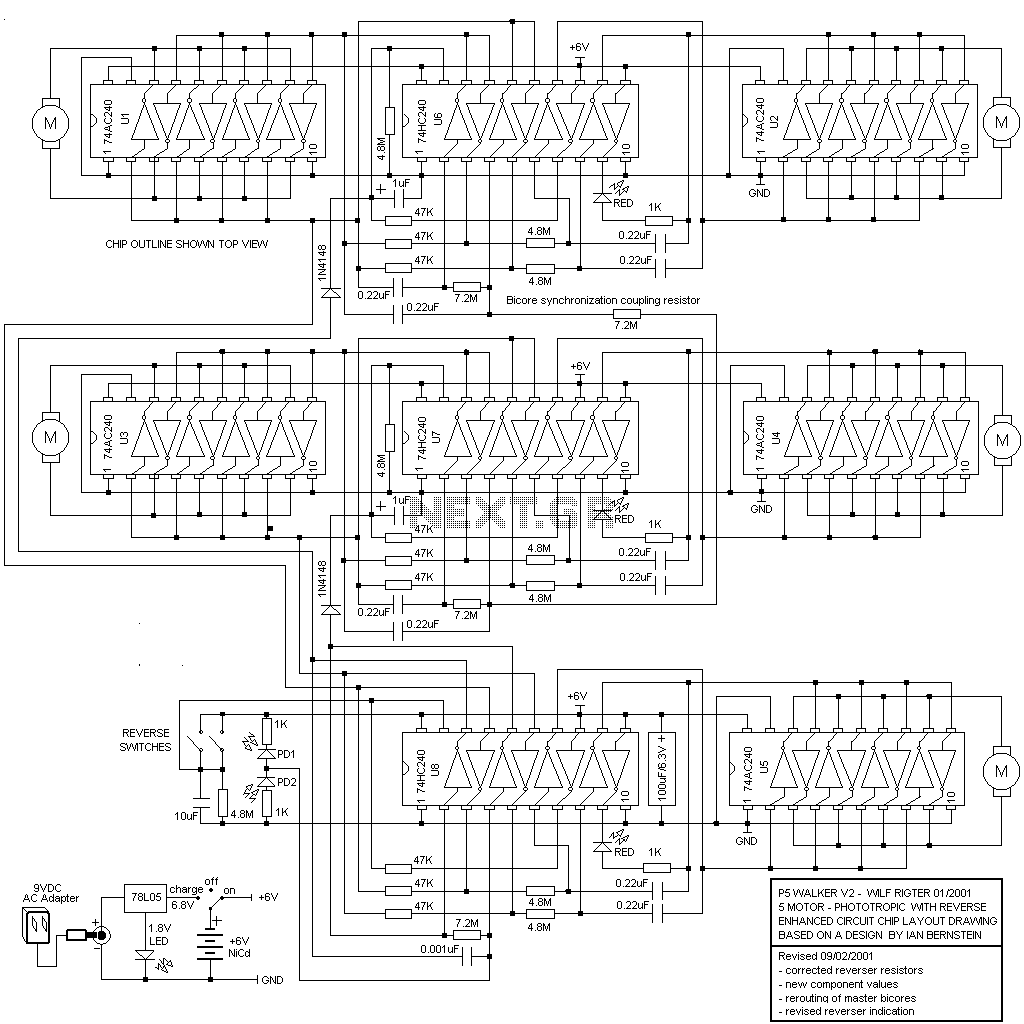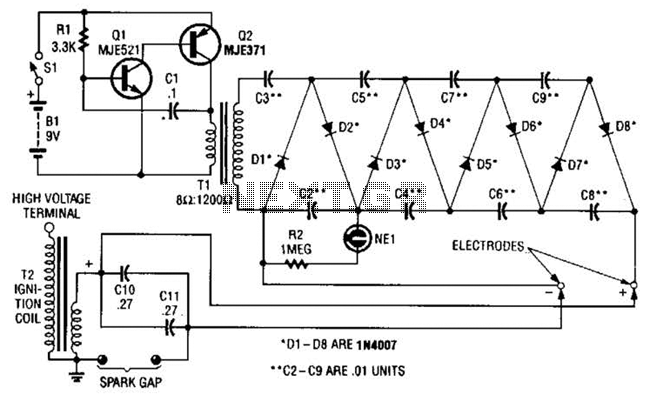
Bridge voltage regulator circuit diagram using the
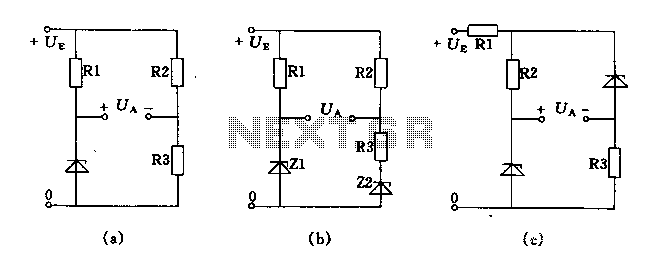
The circuit depicted in Figures A, B, and C demonstrates a high voltage coefficient. When the regulator resistance \( r_z \) is held constant, the bridge configuration achieves an infinite voltage coefficient. In Figure A, the load circuit is connected to the bridge diagonal at the midpoint of regulation, satisfying the condition \( \frac{R_1}{r_z} = \frac{R_2}{R_3} \). The output resistance of this circuit is approximately \( r_z + R_3 \). To minimize the voltage drop across \( R_3 \), it is essential that the output voltage remains stable and equal to the operating voltage \( U_z \). Figure B illustrates a circuit particularly suited for stable low voltage operation, where the output voltage is roughly equal to the difference between the two operating voltage regulators, \( U_{z1} - U_{z2} \). The output resistance in this case is \( r_{z1} - r_{z2} + R_3 \). Figure C is applicable only when the difference between input voltage and output voltage is minimal, necessitating that the two zener voltages be as equal as possible, and that the resistors \( R_2 \) and \( R_3 \) can be matched.
The circuit configurations in Figures A, B, and C are designed to optimize voltage regulation under varying conditions. In Figure A, the bridge circuit is configured to ensure that the ratios of the resistors maintain a balance that allows for a high voltage coefficient, which is critical for applications requiring precise voltage levels. The output resistance, being a function of \( r_z \) and \( R_3 \), indicates that careful selection of these components can enhance performance by reducing losses.
In Figure B, the focus shifts to low voltage stability. The output voltage being the difference between two regulated voltages highlights the importance of selecting zener diodes with closely matched characteristics. This configuration is advantageous in scenarios where a consistent low voltage is required, such as in sensor applications or low-power electronic devices.
Figure C presents a more constrained application, where the voltage differential between the input and output is minimal. This setup necessitates precise matching of the zener voltages to ensure functionality. The equality of resistors \( R_2 \) and \( R_3 \) further stabilizes the output, making this configuration suitable for low-dropout applications.
Overall, these circuit designs exemplify various strategies for voltage regulation, emphasizing the importance of component selection and configuration in achieving desired electrical characteristics. Proper implementation of these principles can lead to improved performance in a wide range of electronic applications.FIG. A ~ c circuit has a high coefficient of voltage. If the regulator resistance rz is constant, while maintaining the delicate balance of the bridge situation has infinite vo ltage coefficient. Figure a load circuit connected to the bridge diagonal at the midpoint of regulation satisfies the condition R1/rz R2/R3, the output resistance of the circuit is about rz + R3. In order to reduce the voltage drop on R3, the output voltage should be stable with pressure pipe is equal to the operating voltage Uz.
Figure b circuit is particularly suitable for low voltage stable. The output voltage is approximately equal to the difference between the two operating voltage regulator, namely Uz1-Uz2. Output resistance is rz1-rz2 + R3. Figure c circuit is only suitable for input voltage and output voltage difference between a small case.
Two zener voltage should be as equal as possible the work, two resistors R2, R3 can be equal.
The circuit configurations in Figures A, B, and C are designed to optimize voltage regulation under varying conditions. In Figure A, the bridge circuit is configured to ensure that the ratios of the resistors maintain a balance that allows for a high voltage coefficient, which is critical for applications requiring precise voltage levels. The output resistance, being a function of \( r_z \) and \( R_3 \), indicates that careful selection of these components can enhance performance by reducing losses.
In Figure B, the focus shifts to low voltage stability. The output voltage being the difference between two regulated voltages highlights the importance of selecting zener diodes with closely matched characteristics. This configuration is advantageous in scenarios where a consistent low voltage is required, such as in sensor applications or low-power electronic devices.
Figure C presents a more constrained application, where the voltage differential between the input and output is minimal. This setup necessitates precise matching of the zener voltages to ensure functionality. The equality of resistors \( R_2 \) and \( R_3 \) further stabilizes the output, making this configuration suitable for low-dropout applications.
Overall, these circuit designs exemplify various strategies for voltage regulation, emphasizing the importance of component selection and configuration in achieving desired electrical characteristics. Proper implementation of these principles can lead to improved performance in a wide range of electronic applications.FIG. A ~ c circuit has a high coefficient of voltage. If the regulator resistance rz is constant, while maintaining the delicate balance of the bridge situation has infinite vo ltage coefficient. Figure a load circuit connected to the bridge diagonal at the midpoint of regulation satisfies the condition R1/rz R2/R3, the output resistance of the circuit is about rz + R3. In order to reduce the voltage drop on R3, the output voltage should be stable with pressure pipe is equal to the operating voltage Uz.
Figure b circuit is particularly suitable for low voltage stable. The output voltage is approximately equal to the difference between the two operating voltage regulator, namely Uz1-Uz2. Output resistance is rz1-rz2 + R3. Figure c circuit is only suitable for input voltage and output voltage difference between a small case.
Two zener voltage should be as equal as possible the work, two resistors R2, R3 can be equal.
